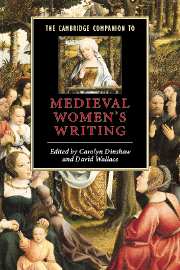Book contents
- Frontmatter
- Introduction
- Part I Estates of women
- Part II Texts and other spaces
- Part III Medieval women
- 10 Heloise
- 11 Marie de France
- 12 The Roman de la Rose, Christine de Pizan, and the querelle des femmes
- 13 Lyrics and romances
- 14 Julian of Norwich
- 15 Margery Kempe
- 16 Continental women mystics and English readers
- 17 Joan of Arc
- Further reading
- Index
15 - Margery Kempe
from Part III - Medieval women
Published online by Cambridge University Press: 28 May 2006
- Frontmatter
- Introduction
- Part I Estates of women
- Part II Texts and other spaces
- Part III Medieval women
- 10 Heloise
- 11 Marie de France
- 12 The Roman de la Rose, Christine de Pizan, and the querelle des femmes
- 13 Lyrics and romances
- 14 Julian of Norwich
- 15 Margery Kempe
- 16 Continental women mystics and English readers
- 17 Joan of Arc
- Further reading
- Index
Summary
One of the many ironies surrounding The Book of Margery Kempe is its now canonical status in English literary history. Identified in the modern era only in 1934, it remained an eccentricity, and a relatively obscure one, until about twenty years ago. Not that it was entirely neglected: J. P. Morgan is reported to have read it on his deathbed. But now it is a staple of American undergraduate English literature education, included in the major anthologies of English literature and routinely taught in introductory classes. Sparkling new editions for the classroom recently have been produced, not to mention a website and postmodern gay novelistic adaptation.
But if her Book has achieved a place in the literary canon, Margery Kempe herself has not been taken entirely seriously as a visionary, let alone a candidate for canonization by the Church. Being proved divinely inspired was never far from her mind: she paid a visit to Julian of Norwich, her contemporary, precisely to be reassured as to her contact with the divine. And canonization was perhaps not absent from the minds of the men who wrote down her book as she dictated it, shaping her reminiscences to fit into a long line of holy women. But Margery’s mystical and prophetic experiences have not been subjected to much serious consideration; the inevitable comparison with Julian of Norwich’s austere and theologically ambitious Revelation has heretofore worked to the disadvantage of the rambling Book of Margery Kempe.
- Type
- Chapter
- Information
- The Cambridge Companion to Medieval Women's Writing , pp. 222 - 239Publisher: Cambridge University PressPrint publication year: 2003
- 2
- Cited by



